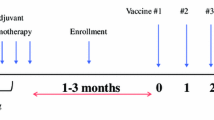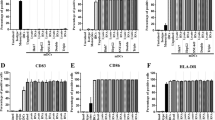Abstract
The murine IgG3 monoclonal antibody NCC-ST-421, raised against a human gastric cancer, shows strong reactivity with dimeric Lea (Lea/Lea; V4FucIII4FucLe6Cer) expressed on gastrointestinal cancer cells. ST-421 reacted minimally with non-dimeric or simple Lea expressed on normal tissues. ST-421 is capable of mediating both antibody-dependent cellular cytotoxicity (ADCC) with human peripheral blood lymphocytes, and complement-dependent cytotoxicity with human complement. Interleukin-2 (IL-2) modulates the function of immunocytes, in particular inducing lymphokine-activated killer (LAK) cell activity and enhancing ADCC. We therefore employed combination immunotherapy with IL-2, LAK, and ST-421-induced ADCC in vitro and in mice with severe combined immunodeficiency (SCID), using target tumor cells expressing Lea/Lea antigen. ADCC against human colon cancer cell lines in vitro was enhanced three to four times after preicubation with IL-2. Addition of IL-2 reduced the amount of ST-421 required for efficient ADCC 10-to 100-fold. ADCC was activated by IL-2 earlier (1 day) than the generation of LAK cells (3–4 days), and at lower concentration of IL-2. These effects were specific for ST-421, as demonstrated by experiments with irrelevant antibody or irrelevant target cells. An anti-(Fc receptor) antibody blocked the ADCC but not the LAK activity in vitro. The enhacement of ADCC by IL-2 may be caused by activation of effector cells expressing Fc receptors. In vivo experiments using SCID mice inoculated with human colon cancer showed a significant tumor-growth-suppressive effect after combined therapy using human peripheral blood lymphocytes, LAK, IL-2, and ST-421. In summary, adoptive immunization with human lymphocytes activated by IL-2 and ST-421 effectively suppressed growth of gastrointestinal cancer cells expressing Lea/Lea.
Similar content being viewed by others
References
Bosma GC, Custer RP, Bosma MJ (1983) A severe combined immunodeficiency mutation in the mouse. Nature 301: 527–530
Cheung N-K, Lazarus H, Miraldi FD, Abramowsky CR, Kallick S, Saarinen UM, Spitzer T, Strandjord SE, Coccia PF, Berger NA (1987) Ganglioside GD2 specific monoclonal antibody 3F8: a phase I study in patients with neuroblastoma and malignant melanoma. J Clin Oncol 5: 1430–1440
Fliet HB, Wright SD, Unkeless JC (1982) Human Fcγ receptor distribution and structure. Proc. Natl Acad Sci USA 79: 3272–3275
Gill I, Agah R, Hu E, Mazumder A (1989) Synergistic antitumor effects of interleukin 2 and the monoclonal Lym-1 against human Burkitt lymphoma cells in vitro and in vivo. Cancer Res 49: 5377–5379
Grimm EA, Mazunder A, Zhang HZ, Rosenberg SA (1982) Lymphokine-activated killer cell phenomenon. J Exp Med 155: 1823–1841
Hank JA, Robinson RR, Surfus J, Mueller BM, Reisfeld RA, Cheung N-K, Sondel PM (1990) Augmentation of antibody dependent cell mediated cytotoxicity following in vivo therapy with recombinant interleukin 2. Cancer Res 50: 5234–5239
Harel W, Shau H, Hadley CG, Morgan ACJr, Reisfeld RA, Cheresh DA, Mitchell MS (1990) Increased lysis of melanoma by in vivo-elicited human lymphokine-activated killer cells after addition of antiganglioside antibodies in vitro. Cancer Res 50: 6311–6315
Honsik CJ, Jung G, Reisfeld RA (1986) Lymphokine-activated killer cells targeted by monoclonal antibodies to the disialogangliosides GD2 and GD3 specifically lyse human tumor cells of neuroectodermal origin. Proc Natl Acad Sci USA 83: 7893–7897
Houghton AN, Mintzer D, Cordon-Cardo C, Welt SW, Fliegel B, Vadhan S, Carswell E, Melamed MR, Oettgen HF, Old LJ (1985) Mouse monoclonal IgG3 antibody detecting GD3 ganglioside: a phase I trial in patients with malignant melanoma. Proc Natl Acad Sci USA 82: 1242–1246
Lotze MT, Frana LW, Sharrow SO, Robb RJ, Rosenberg SA (1985) In vivo administration of purified human interleukin-2. I. Half-life and immunologic effects of the Jurkat cell line-derived interleukin-2. J Immunol 134: 157–166
McCune JM, Namikawa R, Kaneshima H, Shultz LD, Liberman M, Weissman IL (1988) The SCID-hu mouse: murine model for the analysis of human hematolymphoid differentiation and function. Science 241: 1632–1639
Miller RA, Maloney DG, Warnke R, Levy R (1982) Treatment of B-cell lymphoma with monoclonal anti-idiotype antibody. N Engl J Med 306: 517–522
Moiser DE, Gulizia RJ, Baird SM, Wilson DB (1988) Transfer of a functional human immune system to mice with severe combined immunodeficiency. Nature 335: 256–259
Munn DH, Cheung NKV (1987) Interleukin-2 enhancement of monoclonal antibody-mediated cellular cytotoxicity against human melanoma. Cancer Res 47: 6600–6605
Pesando JM, Hoffman P, Conrad T (1986) Malignant human B cells express two populations of p24 surface antigens. J Immunol 136: 2709–2714
Pesando JM, Bouchard LS, McMaster BE (1989) CD 19 is functionally and physically associated with surface immunoglobulin. J Exp Med 170: 2159–2164
Pross HF, Baines MG, Rubin P, Shatagge P, Patterson M (1981) Spontaneous human lymphocyte mediated cytotoxicity against tumor target cells: IX. The quantitation of natural killer cell activity. J Clin Immunol 1: 51–63
Rosenberg SA, Lotze MT, Muul LM (1985) Observations on the systemic administration of autologous lymphokine-activated killer cells and recombinant interleukin-2 to patients with metastatic cancer. N Engl J Med 313: 1485–1492
Sears HF, Herlyn D, Steplewski Z, Koprowski H (1985) Phase II clinical trial of a murine monoclonal antibody cytotoxic for gastrointestinal adenocarcinoma. Cancer Res 45: 5910–5913
Stroud MR, Levery SB, Nudelman ED, Salyan MEK, Towell JA, Roberts CE, Watanabe M, Hakomori S (1991) Extended type 1 chain glycosphingolipids: dimeric Lea (III4V4Fuc2Lc6) as human tumor-associated antigen. J Biol Chem 266: 8439–8446
Watanabe M, Hirohashi S, Shimosato Y, Ino Y, Yamada T, Teshima S, Sekine T, Abe O (1985) Carbohydrate antigen defined by a monoclonal antibody raised against a gastric cancer xenograft. Jpn J Cancer Res (Gann) 76: 43–52
Watanabe M, Ohishi T, Kuzuoka M, Nudelman ED, Stroud MR, Kubota T, Kodaira S, Abe O, Hirohashi S, Shimosato Y, Hakomori S (1991) In vitro and in vivo antitumor effects of murine monoclonal antibody NCC-ST-421 reacting with dimeric Lea (Lea/Lea) epitope. Cancer Res 51: 2199–2204
Yamada T, Hirohashi S, Shimosato Y, Kodama T (1985) Giant cell carcinomas of the lung producing colony-stimulating factor in vitro and in vivo. Jpn J Cancer Res (Gann) 76: 967–976
Author information
Authors and Affiliations
Additional information
This study was supported by the grant Ten Year Strategy for Control of Cancer from the Ministry of Health and Welfare, Japan, and funds from The Biomembrane Institute, in part under a research contract with Otsuka Pharmaceutical Co. S.H. is supported by National Cancer Institute Outstanding Investigator Grant CA42505.
Rights and permissions
About this article
Cite this article
Watanabe, M., Kubota, T., Kitajima, M. et al. Synergetic effect of interleukin-2 and cellular cytotoxicity against a novel tumor-associated carbohydrate antigen Lea/Lea (dimeric Lea) mediated by monoclonal antibody NCC-ST-421 in adoptive immunization using SCID mice. Cancer Immunol Immunother 37, 245–250 (1993). https://doi.org/10.1007/BF01518518
Received:
Accepted:
Issue Date:
DOI: https://doi.org/10.1007/BF01518518




